Genre: Fighting Developer: Sega AM2 Publisher: Sega Ent. Players: 1-2 Released: 1996
It’s difficult to talk about Fighting Vipers without talking about Virtua Fighter, Sega’s other (and considerably more beloved) 3D fighting franchise. In the arcade, Fighting Vipers and Virtua Fighter 2 both shared the same Model 2 hardware. They were both developed by AM2, with only a year between their launches, and both were produced by the legendary Yu Suzuki. There’s little doubt that without Virtua Fighter, there would be no Fighting Vipers, but the core similarities between these early 3D fighters is also what led to key differences in style and substance.
This reality is quickly apparent from the opening FMV sequence that begins if you linger on the game’s start screen; it’s a brief introduction to the eight main fighters (plus a look at the boss, who becomes playable in a modified form). None of them shares the same elegant and understated character designs as Akira or Pai Chan. There’s Grace, for instance, a lady decked out in shocking pink armour and who gets around on rollerblades. And it’s difficult to forget Raxel, the long-haired heavy metal star who takes his equally flamboyant guitar into the fight. Like Sega’s spiky hedgehog mascot, these characters are very ’90s, very Americanized, and very in-your-face. In isolation, their designs are a little too offbeat to feel coherent, but as a complete roster, these guys and girls succeed in forming the backbone of the game’s visual identity.
Fighting Vipers, like Virtua Fighter, uses three basic moves: defend, punch and kick. If, like myself, your first instinct when firing up a new fighting game is to skip the training, dive straight into a match, and hope for the best, you’ll be delighted to know that it’s entirely possible to beat this game’s arcade mode without having the faintest idea what you’re actually doing. Virtua Fighter is quick to punish such impetuousness, but Fighting Vipers is generally content to let you mash buttons, win rounds, and maybe even pull off a few accidental combos in the process.
Is Fighting Vipers shallow, then? Not at all. There’s a robust fighting system in place here, one that can be fully explored in the excellent Training Mode. This mode doesn’t just give you a dummy AI fighter to use as your personal punching bag. It also gives you access to the complete command list of your chosen character, with AI-performed demonstrations available at the touch of a button, and a satisfying “OK” icon awarded to each combo that you successfully pull off. It’s a massive step up from Virtua Fighter’s bare-bones mode select, and it allows Fighting Vipers to effectively compete with the learning environments of other fighters of the time, such as Namco’s Tekken 2. Other modes include VS, Team Battle, and Playback, the last of which allows you to view fights that have been saved to your Saturn’s internal memory/backup memory cartridge.
For single players, Arcade Mode is the main draw, and it doesn’t disappoint. This is a series of nine back-to-back battles against the AI, and it’s where you’ll experience all the sights and sounds that Fighting Vipers has to offer. Environments are urban and often dilapidated, but without feeling seedy or uninviting. Like so many Sega games of the ’90s, it’s a world you wouldn’t mind stepping into. These stages are an obvious upgrade in design and detail from the original Virtua Fighter, but perhaps inferior to the often-breathtaking backdrops of Virtua Fighter 2 (who can forget Shun Di’s glorious riverside stage?). One interesting detail here is that in many of these stages, you can catch a glimpse of the Space Needle-esque tower where the final three battles take place. It’s a nice piece of visual storytelling that makes these places feel more connected and real.
Where Virtua Fighter has ring-outs, Fighting Vipers has walls. These are present in every stage and can change the dynamic of any fight. If your opponent has their back to a wall, some combos will allow your character to slam them against it for extra damage. One of the consequences of this is that both you and your opponent will often scramble to get away from walls, come what may. On the other hand, after mastering some of the game’s more complex combos, you can use these walls as a weapon, climbing atop them before piling down on your foe again, or uppercutting them in such a way that they’re literally caught on the fence. And when you end a battle with a particularly powerful punch or kick, you’ll smash your opponent through the wall, resulting in much debris and a suitably satisfying cacophony.
The other major gameplay innovation here is the inclusion of an armour system. All fighters have top armour and bottom armour, which is gradually worn down as they take damage. When armour is fully depleted, it shatters (accompanied by a rapid replay of the destruction and, in the case of two of the three female characters, a little titillation). From here, the character now takes more damage but moves faster. It’s an interesting system, although on the game’s default settings, armour is often only broken in the last moments of a fight and rarely feels like a game changer. Fortunately, Fighting Vipers does offer a rich suite of options, where longer and harder matches force you to engage with all the available mechanics.
Musically, Fighting Vipers is all about that electric guitar, and some peppy synth besides. Like the environments, the soundtrack avoids the trap of becoming grungy or downbeat. These tracks want you to have a good time, and if none of them are likely to find their way onto your personal playlist, there’s a good chance some of them will get stuck in your head. The sound effects are, if you’ll pardon the pun, punchy. And each character’s voice samples, although prone to repetition, are suitably memorable and go a long way in reinforcing their individuality. Special mention goes to Sanman and his passionate grunts.
How does the Saturn conversion compare to the arcade original? Highly favourably. While the Saturn version loses the wonderful 3D backgrounds and the more vibrant colours, it’s astonishing how well the 32-bit console captures the overall aesthetic of its more powerful arcade counterpart. Vitally, the moment-to-moment gameplay barely seems to have slowed down at all. It’s a marvelous realisation of Sega’s long-standing ambition to bring the arcade to the home with minimal compromise. Because of AM2’s programming magic, Fighting Vipers absolutely holds its own not just against the home conversions of other fighting games of its era, but also the ones that are on the market today, almost 30 years later.
This game wouldn’t be the only appearance of Grace, Raxel, Sanman and the others on the Saturn. A year later, they’d appear in the critically acclaimed Fighters Megamix, which combined the world of Fighting Vipers with the world of Virtua Fighter. Fighting Vipers also received a direct sequel in arcades and on the Dreamcast, although not in the U.S. and not to any meaningful fanfare. It’s safe to say that Fighting Vipers has since fallen into obscurity, with even a fully playable version in Sega’s much more recent action-adventure sandbox Judgment doing nothing to get people talking, let alone clamouring for a new installment.
For my part, I remember picking up Fighting Vipers around the same time I picked up Virtua Fighter one and two for my Saturn. Although I liked all three games, it was Fighting Vipers that I spent the most time with. It’s not just because it has an accessibility that readily lures you in. It also has more personality than the austere Virtua Fighter, even if that series is ultimately the more refined of the two. To put it another way, if Virtua Fighter is the revered grandfather of 3D fighting games, Fighting Vipers is the nepotistic son who, against all the odds, actually has some talent.
Score: 8 out of 10


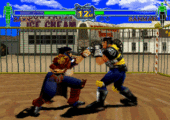
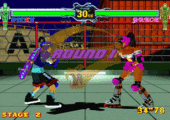
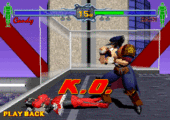
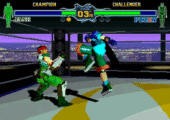
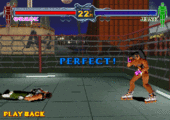
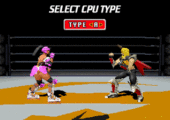
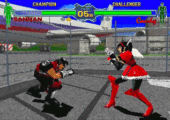
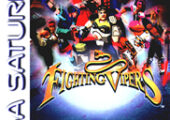
Recent Comments